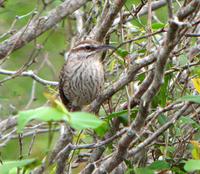Yucutan Wren - Iain Campbell
Tropical Birding tour report: The Yucutan and Palenque
Yucutan Wren - Iain Campbell
The first stop this morning was the nearby botanic gardens. Just a few
minutes after arriving we were finding Yucat??n endemics:
Yucat??n Woodpecker, Yucat??n
Vireo, White-browed Wren, and Black Catbird. Flocks of Neotropical
migrants
were quite conspicuous. Northern Parula, American Redstart, Northern
Waterthrush, and “Myrtle”, Black-throated Green,
“Western” Palm, and
Black-and-white Warblers made up the bulk, with small numbers of Lesser
Greenlet, Bananaquit, and White-eyed Vireo. Roving flocks of Brown Jays
screamed as they passed overhead, loosely associated with a nice mix of
orioles: Altamira, Black-cowled, and Hooded. Green-backed Sparrows and
Red-throated Ant-Tanagers called from the undergrowth. Large flocks of
migrant
Indigo Buntings had some “Eastern” Blue Buntings
and Yellow-faced Grassquits
mixed in. A very confiding Ivory-billed Woodcreeper gave us our first
looks at
that tropical family.
After
a leisurely lunch we
headed west to Chich??n Itz??. The main attraction
here, El Castillo, is amazing
and incredibly intact for such an old structure. We spent most of our
time here
simply enjoying the ruins rather than outright birding, but we did see
a few
birds along the way. Yellow-backed Oriole, Cinnamon Hummingbird,
Rose-breasted
Grosbeak, and Scrub Euphonia were noted.
31 Jan:
An early morning start had us outside R??o Lagartos by sunrise.
Immediately we
found both Couch’s and Tropical Kingbirds singing away. A
family of Orange
Orioles showed nicely in the warm morning light as Yucat??n
(Black-throated)
Bobwhites sang nearby. We had nice looks at a stunning male Mexican
Sheartail. Aztec
Parakeets and White-fronted Amazons were both common and conspicuous as
they
flew about in noisy flocks. A Laughing Falcon perched up high while a
pair of
Crested Caracaras flew by. Investigation of piercing screaming calls
turned up
a pair of Limpkins perched on a dead snag, seemingly out-of-place in
the dry
desert scrub. They were using nearby marsh habitat, though, and we soon
encountered other marsh birds like Crane Hawk and Tricolored
Heron. |

